Who are the hunter gatherers of Southern Africa?
You may be under the impression that there are no more hunter gatherers living today. But there are! All over the world, in every country from Brazil to Australia, you will still find people living as hunter gatherers. This way of living is hundreds of thousands of years old. Imagine that! Living the exact same way as someone did during the time when fire was first discovered.
The hunter gatherers of Southern Africa are people known as the San and Khoi-Khoi. Archeologists have estimated that hunter-gatherers have been around in Southern Africa for approximately 11 000 years. The name ‘San’ comes from the Khoi-Khoi word ‘Saan’, which means 'people who gather wild food' or 'people without any cattle'. In South Africa we use the name ‘San’ to describe the indigenous people of Southern Africa who live or used to live by hunting and gathering.
Did you know that the European settlers had many names for the hunter gatherers? These included Bosjesman, Soaqua, Bushmen, `Sarwa' or `Basarwa', and `Twa'.
Hunter gatherers from around the world
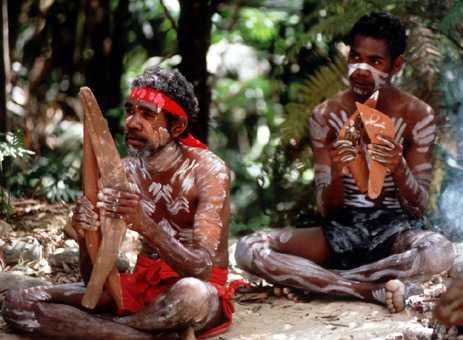 Aborigines Image source
Aborigines Image source
Through archaeological research and San oral history or storytelling we know that there were a lot of San groups living in the Southern Kalahari. Archaeologists believe that the San were the descendants of the original homo sapiens who had lived in South Africa for at least 150 000 years. That must be one very long and big family tree!
Today we still see evidence of cultural practices that are being used by Southern African hunter-gatherers. Examples are the making of ostrich eggshell beads, shell ornaments, the bow and arrow and rock art.
Life of the San changes forever: The arrival of the Europeans
When the Europeans arrived at the Cape of Good Hope in 1652, they brought advanced weapons and new diseases. The European diseases, such as Smallpox, caused thousands of San and Khoi people to die during the 18th and 19th centuries. With their advanced weaponry, the Europeans were also able to force the Khoi and San off their land. Because of this, many South African San people either died of disease or were forced to join other clans for survival.
 Khoikhoi tribe man from South Africa Image Source
Khoikhoi tribe man from South Africa Image Source
The San
In this section we will learn all about the life of the San. We will look at the following:
- Who are the San?
- San community and beliefs
- San customs and religion
- San food
- San clothing
- San medicine
- San rock art.
Who are the San?
When the Europeans came to Africa, they thought that the indigenous people were very primitive. How wrong they were! Little did the Europeans know how clever the San were! Even though the San were using Stone-Age technology, these hunter-gatherers were very skilled.
The San were able to follow the seasons and know where the plants for food would grow, making sure not to pick too many plants and damage the environment. They also had to follow the migration of the antelope for hunting to ensure that they would never go hungry, and know the different places to get water so that they would not go thirsty. If anyone became ill, they would also know which plants to use as medicine.
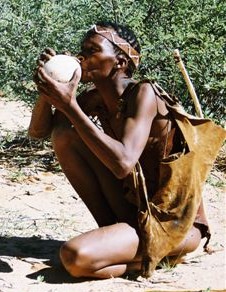 San Bushmen Image Source
San Bushmen Image Source
In the San society, the women would go out and pick the plants and herbs for food, and the men would hunt and go fishing. They would only hunt what they could eat, never hunting for sport. When an antelope was killed, they would use every part of the animal, so that nothing went to waste. This was because they respected the animal for sacrificing its life so that they could eat it. Because the San were always moving, they lived either in caves, camped out in the open or made their homes out of materials that were easily available such as long grass, thin branches and rocks.
To create their paintings the San used brushes and paint. Brushes were made using either feathers or animal hair and thin reeds. We can identify what they used by the brushstrokes that can be seen in the paint. The paint was made by mixing pigment with whatever was available, be it eggs, animal blood, water or saliva. Often they would use animal blood or special herbs to make the magic of the art more powerful. The most popular and common shade of paint used by rock artists was made of red ochre pigment, which was easy to obtain, being mined in Swaziland. Yellow ochre was also easy to find and was often used. White paint came in three different shades and researchers believe this was made from different shades of white clay or from bird poop. Black paint came from charcoal and manganese oxide.
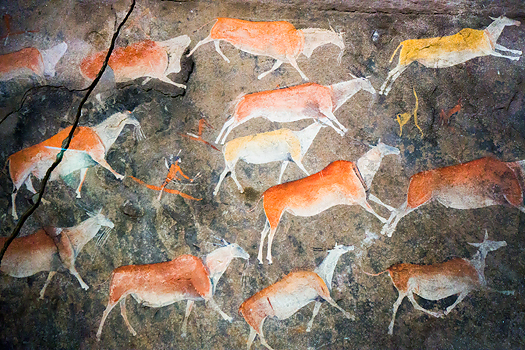 Image_rock Image source
Image_rock Image source
There are many different shades and colours but black, brown, red, yellow and white were more easily available to the average San rock artist. Etchings of images were also very common. The artist would scrape and chip out pieces of rock from the greater surface and create beautiful art. They would use pieces of rock and sharpened sticks to create images. It is difficult for archaeologists to say exactly when any particular rock art was made because the art does not change very much with age and because most of the art is in caves, protected from being damaged by wind, rain or anything else.
The Linton Panel
The Linton Panel is one of the most famous pieces of rock art made by the San. This was found in a cave on a farm called Linton in the Eastern Cape, but has since been moved to the South African Museum in Cape Town. It is thought that the painting shows a San figure gaining great power from his main god. The San were said to use the power from the main god to benefit their community, for example, healing the sick and creating unity. The San believed that their art had special powers. When South Africa became a democracy in 1994, a new Coat of Arms was created. In the Coat of Arms, we see the San figure from the Linton Panel, which was used to assume the same power from the rock art to create ‘unity from diversity’. This is represented as two figures greeting one another.
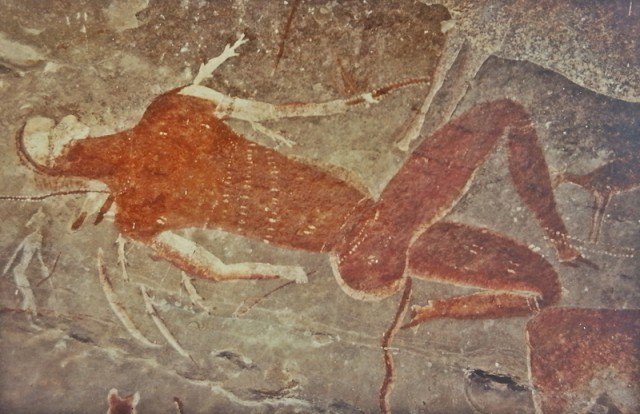 The'Linton panel' Image source
The'Linton panel' Image source
The Khoi Khoi - Herders of Southern Africa
The San were not the only inhabitants of Southern Africa before the European settlers arrived. The Khoi-Khoi were a group of people who also inhabited Southern Africa. The name Khoi-Khoi means ‘people of people’ or ‘real people’ and they were also hunter gatherers, BUT there was one very big difference. They were herders too! They would herd livestock such as cattle. Having livestock was a symbol of wealth for the Khoi Khoi, especially cattle, as cattle were prized and would only be slaughtered for celebrations. Instead of having a bank account with money in it the Khoi Khoi had their cattle. The Khoi-Khoi also used their oxen to carry loads and to ride. Other livestock, such as goats and sheep, were more frequently slaughtered for their meat and fat, but would also provide milk for the tribe.
To ensure that the Khoi-Khoi livestock always had enough grazing land, the Khoi-Khoi would move from place to place to give the land a chance to regenerate.
They also gathered their food and needed to ensure that there was always enough to last for a long time. As the Khoi- Khoi were nomadic, their houses had to be easy to take down and put up, so they used young trees called saplings to build basic dome-like structures and covered them with woven reed mats. These mats were well-suited for covering the structures because in hot weather they would provide shade and allow air to flow in the gaps between the reeds. When it rained the reeds would swell up and prevent water from entering the structure. This meant that they were able to keep cool in hot weather and dry and warm in cold weather. For extra insulation in those cold winter months, the Khoi-Khoi would often put sheep and goat skins against the walls just as we use synthetic insulation in our houses today. In the Khoi- Khoi community, there were approximately 100 people in each village.
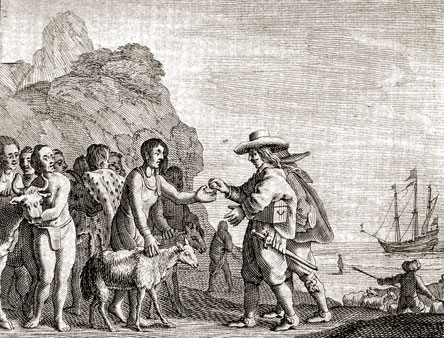 Khoi bartering © NLSA Image source
Khoi bartering © NLSA Image source
Unlike the San the Khoi Khoi had a hierarchical society structure. There was a chief, headman, elders, servants and other members in the village that had specific hierarchical positions based on how much cattle they owned. The wealthier members of the community would gain importance by donating cattle to be slaughtered for community celebrations such as weddings and funerals. The chief would be responsible for maintaining harmony and making decisions in the community. He would own the most cattle and was the wealthiest man in the community. The role of chief would be passed on to his eldest son when he died, thus all the chiefs would be from the same family.
The Khoi-Khoi were very good at craftwork. They made clothing, bags and blankets from animal skins. They also made pottery with pointed bases and handles that strapped easily to the backs of oxen or to their shelters. They used the reeds for making mats for their houses and sleeping mats. The Khoi-Khoi were also very skilled at making weapons. They made spears with hardened points of iron that they gained from trading with neighbouring tribes or European settlers. After any celebration or successful hunt, the meat would be shared in the community.The best pieces of meat would go to the wealthiest members of the tribe. In this way, the Khoi- Khoi looked after one another.
Historical evidence, for example rock paintings, show that the San people lived in the Kalahari, a vast desert that stretches over South Africa, Botswana and Namibia, from about 25 000 BC. The San are believed to be the original human inhabitants of Southern Africa and are the oldest culture in the world The San people survived in small numbers in the Kalahari Desert, as well as settling along the coast. Historical evidence found in coastal caves indicates that the San people were accomplished fishermen. The San people are often referred to as „Bushmen‟ but this is sometimes viewed as an offensive term and is therefore not used. They are physically quite small and have a unique “click” language. They used various skills to survive in the harshest of conditions.
Nomads
The San were hunter-gatherers and lived off the land by mainly hunting for wild game and gathering plants. Hunter-gatherers are „nomads‟ (people who do not live permanently in an area). The San people moved depending on the migration patterns of the animals that they hunted as well as in search of water. The San went on the move in search of food, if weather conditions changed and would leave a place if someone has died or if there had been a serious misfortune there. The San would not return to the place until the grave or event had been forgotten by all.
Hunting
The San lived in the „Stone Age’ period which meant they did not use metal, but their weapons and tools were made of wood, stones and bones. The San invented their own type of bow and arrow, which was very effective for hunting antelope and buffalo. They used handbows with arrows dipped in poison. The poison was made from snake venom, plants and beetle larvae. They would dip their spears into this poison. Before going to hunt, the San would conduct a religious ceremony to prepare themselves. This has been recorded in their rock art. The San were excellent trackers and hunters and could follow the ‘spoor’ (tracks) of an animal across any type of terrain. They could identify the spoor of a wounded animal and track it down. They understood the habits of wild animals. They also set traps for animals, near places where animals come to drink water, for example. The poison would take a while to sedate the animal, which meant that the San would often have to track the injured animal for days. They would offer thanks to the animal‟s spirit after it was killed.
Food
The San ate the animals that they hunted and the fruit and seeds that they gathered. They also ate insects, such as beetles, caterpillars, moths, butterflies and termites. Wild honey was a favourite delicacy.
Housing
Due to the San‟s nomadic lifestyle, they did not build permanent settlements. Instead, they stayed in rock shelters and/or open camps near waterholes. The shelters were made from materials that they found around them, for example thin branches, grasses and rocks. The women were in charge of building the shelters. A shelter could be erected in less than an hour. Huts were usually built in a circular arrangement around a central fireplace. Due to their nomadic lifestyle, the San did not keep domesticated animals, nor did they farm crops. They did not make pottery, but instead used ostrich egg-shells for storing and holding liquids. These ostrich egg-shells were placed underground to keep the liquids cool. Plant Medicine Women would collect different herbs and bulbs for use in the preparation of medicine. Often San men would chew on „Hoodia Gordonii‟ on long hunting trips. This bitter plant would suppress their appetite for 24 hours, so they were not hungry. Recently, this plant has been used in modern day medicine to help cure obesity.
Marriage and Children
The San men and women married very young, the women usually at the age of 7-9 years and boys at about 14 years old. The majority of the marriages were „monogamous’(one partner) however the San do practise „polygamy’ (more than one partner). In most tribes, hunting was regarded as extremely important in finding a wife. A hunter would hunt a large animal and the best pieces of the meat would go the daughter‟s parents. If the parents accepted the meat, then the hunter was allowed to marry their daughter. Sometimes San marriages were arranged by parents.
Clothing
Most San wore very little clothing. Men usually wore a small piece of animal skin between their legs, which was tied in the front, around their loins. The women wore a small piece of skin in the front, decorated with beads. They seldom wore anything covering their shoulders, except in cold weather. Both men and women wore ornaments such as necklaces, bracelets, earrings and hair ornaments. Necklaces were made from small berries, beads, ostrich shells, bones, teeth and animal claws.
Religion
The San believed in „Kaggen’, the creator of many things. Kaggen translates to ‘mantis’ which is why the San respected the Preying Mantis.
Example of a San Folklore The Sun, Moon and the Stars
A young woman waited for the hunters to return every night. When it grew dark she threw white ash into the night sky. This became the Milky Way and guided the hunters‟ home. The moon is believed to be the old shoe of ‘Mantis’. Mantis placed it in the night sky to guide him. The sun was very jealous of the moon and started to cut off pieces of the moon, bit by bit. The moon begged the sun to stop and go away. Soon after, the moon started growing and the whole process started again. The San people believed in one powerful God, although they also believed in other, minor Gods. Offerings were made to the dead ancestors. Some groups also worshipped the moon. They believed that after death, the soul went to God‟s house in the sky.
Music and Dance
The San made musical instruments and were skilful musicians. Dancing rituals, such as a healing or rain dance were done. These dances are often shown in the rock art. The San often went into trances during these dances.
Rock Art
Rock art is a term used to describe paintings or engravings on rocks or in caves. There is evidence of thousands of rock paintings all over southern Africa. The majority of this rock art was done by the San people. South African rock art was only discovered about 350 years ago and is found in rocky areas of KwaZulu-Natal, the Eastern and Western Cape. Rock paintings are found in caves and rock shelters, whereas rock engravings occur in rocky outcrops, riverbeds or on flat rocks in the veld. In rock engravings, animals are more common than human figures. The Eland (an antelope species) is often seen in rock art The San rock art depicts the religious beliefs and practises of the time. The rock paintings provide us with insight into the lives of the San people. The San would draw the art in a trance-like state. This trance-like state was brought about through medicine, dancing and drumming. It was a way in which the artist could connect with their ancestors and the spiritual world.The San used brushes made from animal hair or bird feathers for painting.For engraving, the San used hard, sharp objects, for example spears orsharp stones. The San would paint with red, brown and yellow pigments.White was made from white clay or bird droppings, black from manganese minerals and charcoal. Blue and green were never used. The blood of an Eland was often mixed with the pigments. Rock art often depicts human figures with long sticks and animals galloping or leaping.
The San People Today
The San people are a peaceful and friendly people who have lived in harmony with nature for at least 20 000 years. The San had their lands invaded by cattle herding tribes (the Khoikhoi) from around 1 500 years ago, as well as by many colonists (white people) who tried to take over their land. The conflict between the Khoikhoi and the San led to the San leaving certain areas to continue their way of life in mountainous and desert areas. Some even joined the Khoikhoi tribes Today the San are found in the North-western Cape, the Kalahari, Namibia and Botswana. They are less nomadic than their ancestors. Many San have changed their old ways of life and have adopted a more modern way of living, as they were unable to continue as huntergatherers, because they could not roam freely. The total population of the San people is estimated at 95 000 today, of which only 3000 follow their traditional ways of hunter-gathering. In South Africa, most of the San people have had their land rights recognised, but San tribes in other places have not. The term „Khoisan‟ refers to both the San and Khoikhoi people. The picture of Khoisan people appears these days on the South African Coat of Arms. The logo on the Coat of Arms means ‘diverse people unite’ and the Khoisan people in the logo represents channelling power to benefit all people in South Africa. The figures in the Coat of Arms come from the Linton Panel, a famous piece of rock art which is now found in the South African Museum in Cape Town. It is one of the best preserved pieces of rock art. The painting shows people capturing a power which the San used to heal the sick and to benefit the community.
Further reading
- The San Hunter - Gather Society
